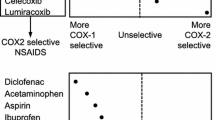Abstract
Clinical studies of selective and nonselective inhibitors of cyclooxygenase-2 (COX-2) provide evidence that inhibition of the enzyme is associated with modestly increased risks of cardiovascular thrombotic events. Investigation of the physiology of COX-2 demonstrates a complex array of interlinked factors affecting its regulation and function. Efficient integration of data from the basic sciences and randomized and observational studies is necessary to fully understand the consequences of COX-2 inhibition and thereby provide guidance for the safe use of COX-2-inhibiting drugs.
Similar content being viewed by others
References and Recommended Reading
Silverstein FE, Faich G, Goldstein JL, et al.: Gastrointestinal toxicity with celecoxib vs nonsteroidal anti-inflammatory drugs for osteoarthritis and rheumatoid arthritis: the CLASS study: A randomized controlled trial. Celecoxib Long-term Arthritis Safety Study. JAMA 2000, 284:1247–1255.
Bombardier C, Laine L, Reicin A, et al.: Comparison of upper gastrointestinal toxicity of rofecoxib and naproxen in patients with rheumatoid arthritis. N Engl J Med 2000, 343:1520–1528.
Mitchell JA, Evans TW: Cyclo-oxygenase-2 as a therapeutic target. Inflamm Res 1998, 47(Suppl 2):S88–S92.
Mukherjee D, Nissen SE, Topol EJ: Risk of cardiovascular events associated with selective COX-2 inhibitors. JAMA 2001, 286:954–959.
Kearney PM, Baigent C, Godwin J, et al.: Do selective cyclo-oxygenase-2 inhibitors and traditional non-steroidal anti-inflammatory drugs increase the risk of atherothrombosis? Meta-analysis of randomized trials. BMJ 2006, 332:1302–1305.
Cannon CP, Curtis SP, Fitzgerald GA, et al.: Cardiovascular outcomes with etoricoxib and diclofenac in patients with osteoarthritis and rheumatoid arthritis in the Multinational Etoricoxib and Diclofenac Arthritis Long-term (MEDAL) programme: a randomised comparison. Lancet 2006, 368:1771–1781.
Hernandez-Diaz S, Varas-Lorenzo C, Garcia-Rodriguez LA: Non-steroidal anti-inflammatory drugs and the risk of acute myocardial infarction. Basic Clin Pharmacol Toxicol 2006, 98:266–274.
Singh G, Wu O, Langhorne P, Madhok R: Risk of acute myocardial infarction with nonselective non-steroidal anti-inflammatory drugs: a meta-analysis. Arthritis Research & Therapy 2006, 8:R153.
McGettigan P, Henry D: Cardiovascular risk and inhibition of cylcooxygenase: a systematic review of the observational studies of inhibitors of cyclooxygenase-2. JAMA 2006, 296:1633–1644.
Garcia Rodriguez LA, Patrignani P: The ever growing story of cyclo-oxygenase inhibition. Lancet 2006, 368:1745–1747.
Helin-Salmivaara A, Virtanen A, Vesalainen R, et al.: NSAID use and the risk of hospitalization for myocardial infarction in the general population: a nationwide case-control study from Finland. European Heart Journal 2006, 27:1657–1663.
Andersohn F, Suissa S, Garbe E: Use of first-and second-generation cyclooxygenase-2-selective nonsteroidal antiinflammatory drugs and risk of acute myocardial infarction. Circulation 2006, 113:1950–1957.
McGettigan P, Henry DA, Han P: Cyclo-oxygenase-2 inhibitors and coronary occlusion — exploring dose-response relationships. Br J Clin Pharmacol 2006, 62:358–365.
McAdam B, Catella-Lawson F, Mardini IA, et al.: Systemic biosynthesis of prostacyclin by cyclooxygenase (COX)-2: the human pharmacology of a selective inhibitor of COX-2. Proc Natl Acad Sci USA 1999, 96:272–277.
Simon LS, Lanza FL, Lipsky PE et al.: Preliminary study of the safety and efficacy of SC-58635, a novel cyclooxygenase 2 inhibitor. Arth Rheum 1998, 41:1591–1602.
Crofford L: Expression and regulation of COX-2 in synovial tissues of arthritis patients. In Improved Non-Steroidal Anti-Inflammatory Drugs: COX-2 Enzyme Inhibitors. Edited by Vane J, Botting J, Botting R. London: Kluwer Academic Publishers & William Harvey Press; 1996:133–143.
Crofford LJ, Lipsky PE, Brooks P, et al.: Basic biology and clinical application of specific cyclooxygenase-2 inhibitors. Arthritis Rheum 2000, 43:4–13.
Fitzgerald GA, Patrono C: The coxibs, selective inhibitors of cyclooxygenase-2. New Engl J Med 2001, 345:433–442.
Mitchell JA, Warner TD: COX isoforms in the cardiovascular system: understanding the activities of non-steroidal anti-inflammatory drugs. Nature Reviews Drug Discovery 2006, 5:75–86.
Grosser T, Fries S, Fitzgerald GA: Biological basis for the cardiovascular consequences of Cox 2 inhibition: therapeutic challenges and opportunities. JCI 2006, 116:4–15.
Catella-Lawson F, McAdam B, Morrison B, et al.: Effects of specific inhibition of cyclooxygenase-2 on sodium balance, hemodynamica, and vasoactive eicosanoids. J Pharmacol Exp Ther 1999, 289:735–741.
Belton O, Byrne D, Kearney D, et al.: Cyclooxygenase-1 and-2-dependent prostacyclin formation in patients with atherosclerosis. Circulation 2000, 102:840–845.
Falk E, Shah PK, Fuster V: Coronary plaque disruption. Circulation 1995, 92:657–671.
Cipollone F, Fazia M, Mezzetti A: Novel determinants of plaque instability. J Thromb Haemostasis 2005, 3:1962–1975.
Rabausch K, Bretschneider E, Sarbia M, et al.: Regulation of thrombomodulin expression in human vascular smooth muscle cells by COX-2-derived prostaglandins. Circ Res 2005; 96:e1–e6.
Hansson GK, Robertson AK, Soderberg-Nauder C: Inflammation and Atherosclerosis. Annu Rev Pathol Mech Dis 2006, 1:297–329.
Stoll G, Bendszus M: Inflammation and Atherosclerosis: Novel insights into plaque formation and destabilization. Stroke 2006, 37:1923–1932.
Egan KM, Wang M, Lucitt MB, et al.: Cyclooxygenases, thromboxane and atherosclerosis — plaque destabilisation by cyclooxygenase-2 inhibition combined with thromboxane receptor antagonism. Circulation 2005, 111:334–342.
Bolli R: Preconditioning: a paradigm shift in the biology of myocardial ischaemia. Am J Physiol Heart Circ Physiol 2007, 292:H19–H27.
Shinmura K, Tang XL, Wang Y, et al.: Cycoooxygenase-2 mediates the cardioprotective effect of late phase pre-conditioning in conscious rabbits. Proc Natl Acad Sci USA 2000, 97:10197–10202.
Bolli R, Shinmura K, Tang XL, et al.: Discovery of a new function of cyclooxygenase (COX)-2: cyclo-oxygenase-2 is a cardioprotective protein that alleviates ischemia/reperfusion injury and mediates the late phase of preconditioning. Cardiovasc Res 2002, 55:506–519.
Rodrigues DA: Impact of CYP2C9 genotype on pharmacokinetics: are all cyclo-oxygenase inhibitors the same? Drug Metab Dispos 2005, 33:1567–1575.
Fries S, Grosser T, Price TS, et al.: Marked inter-individual variability in the response to selective inhibitors of cyclooxygenase-2. Gastroenterology 2006, 130:55–64.
Papafili A, Hill MR, Brull DJ, et al.: Common promoter variant in cyclooxygenase-2 represses gene expression: evidence of role in acute inflammatory response. Arterioscler Thromb Vasc Biol 2002, 22:1631–1636.
Cipollone F, Toniato E, Martinotti S, et al.: A polymorphism in the cyclooxygenase-2 gene as an inherited protective factor against myocardial infarction and stroke. JAMA 2004, 291:2221–2228.
Skarke C, Reus M, Schmidt R, et al.: The cyclooxygenase 2 genetic variant-765G-C does not modulate the effects of celecoxib on prostaglandin E2 production. Clin Pharmacol Ther 2006, 80:621–632.
Author information
Authors and Affiliations
Corresponding author
Rights and permissions
About this article
Cite this article
McGettigan, P., Henry, D. COX-2, NSAIDs, and cardiovascular risk. Curr Cardio Risk Rep 1, 296–302 (2007). https://doi.org/10.1007/s12170-007-0048-y
Published:
Issue Date:
DOI: https://doi.org/10.1007/s12170-007-0048-y




